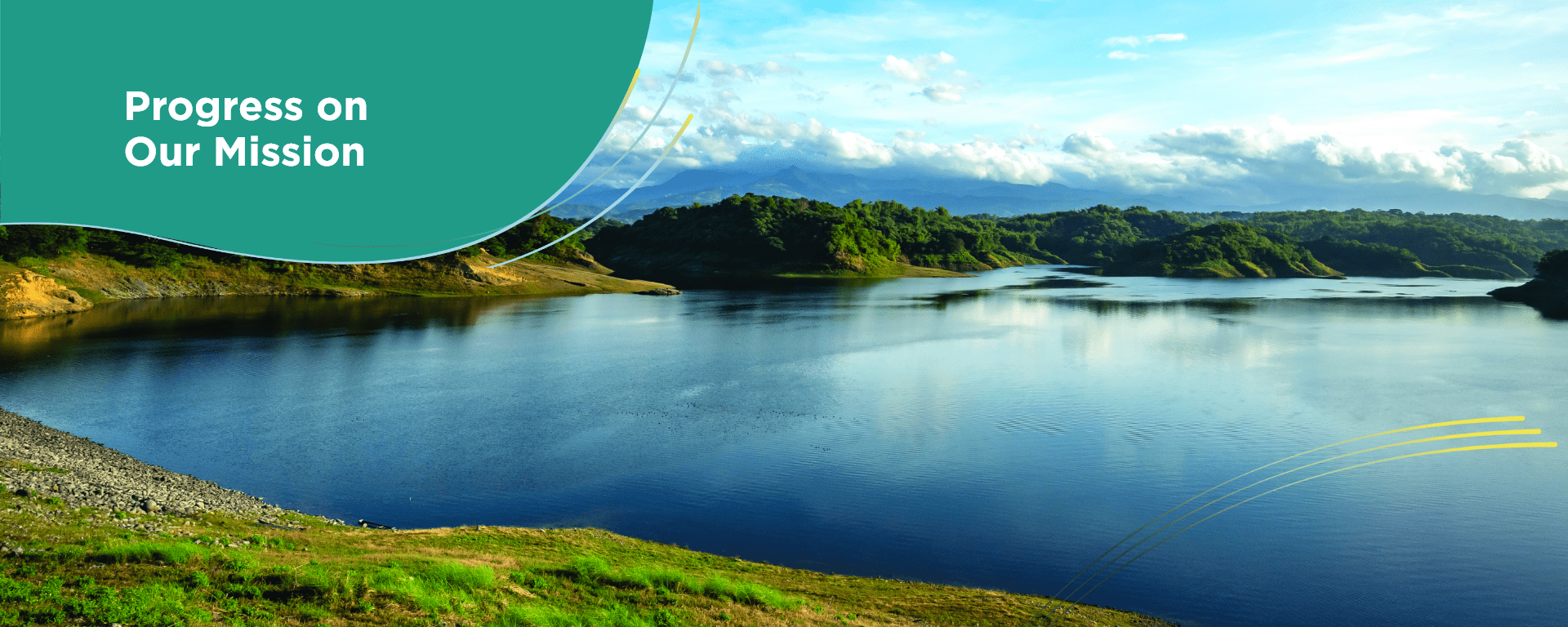| 1.0 GOVERNANCE PILLAR |
| 1.1 Governance |
Adoption of the unified FPH mission. Subsidiaries were given the flexibility to modify the mission to fit their operations. |
We adopted the mission of “to forge collaborative pathways to a decarbonized and regenerative future,” and established our strategic objectives to produce and offer clean and sustainable energy solutions:
- Grow by expanding our clean energy portfolio
- Spur decarbonization by collaborating with regenerative partners
- Go beyond shareholder value by creating stakeholder value—particularly by enabling our organization and creating value for our communities, environments, and other stakeholders
The Company’s mission and goals are embedded in the organization’s planning processes, which help ensure that First Gen’s strategies are aligned with our mission, purpose, and chosen path.
|
| 2.0 ENVIRONMENTAL PILLAR |
| 2.1. Energy efficiency |
Energy audits guided by Republic Act 11285 (Energy and Conservation Act of the Philippines) |
In 2023, as part of our continuing compliance with DOE’s Department Circular 2019-11-0014, the Implementing Rules and Regulations of RA 11285 Energy Efficiency and Conservation Act, our First Gen subsidiaries, EDC and FGHPC completed their respective energy audits.
|
| 2.2. Waste management |
Waste management plan |
We established waste management processes by implementing guidelines on proper handling, waste storage, and disposal according to regulatory requirements. As a result, almost 50 percent (844.6 metric tons) of our waste were diverted from the landfill. We continue to partner with organizations such as ABS-CBN Lingkod Kapamilya Foundation-Bantay Kalikasan to recycle waste oil, lead, and plastic casings of batteries.
We minimize waste generation through proper and timely maintenance of our equipment, spill prevention measures, the use of appropriately-sized materials, paper recycling, and paperless transactions. We will revisit a more robust waste management plan.
|
| 2.3 Water consumption |
Water management plan |
We have also established significant efforts to monitor and manage how we consume water in our areas. First Gen is already a responsible manager of our water consumption across all our facilities. Moving forward, we endeavor to go beyond and find ways to improve our impact on overall water consumption in our communities.
|
| 2.4. Decarbonization |
Climate risk and opportunity analyses across the value chain
Preliminary decarbonization plan (to be continuously refined as new measures become available)
|
In early 2022, we determined the physical and transition climate risks and opportunities and existing mitigating measures. We continue to implement the measures on climate risks and opportunities and monitor their effectiveness.
Our decarbonization plans include:
- Growing our low-carbon portfolio through increased renewables and higher efficiency gas turbines, ultimately aiming to expand the proportion of renewables in our portfolio
- Exploring the use of nature-based solutions and storage technology to complement our efforts to increase renewables
- Closely monitoring emerging decarbonizing technologies such as carbon capture, utilization and storage, as well as hydrogen to supplement natural gas
- Getting external assurance on our Scope 1 and Scope 2 Greenhouse Gas (GHG) emissions. For Scope 3 GHG emission, we are in the stage of improving our existing processes to enable accurate data collection and accounting.
|
| 2.5. Biodiversity |
Biodiversity conservation and monitoring program for subsidiaries with major dependency on nature
|
We maintained our biodiversity programs, such as BINHI: A Greening Legacy, a broadscale reforestation and biodiversity initiative, and the Project Center of the Center (Project CoC), which involves marine conservation work in the Verde Island Passage with local communities. Furthermore, we continue to explore other program opportunities to further contribute to preserving biodiversity as well as addressing related societal issues.
|
| 3.0 SOCIAL PILLAR |
| 3.1. Human rights |
Human rights due diligence across the value chain (potential human rights impact assessment, measures, and grievance redress mechanism),
Vendor engagement (Supply chain sustainability)
|
We established Vendor Grievance Redress Mechanism Guidelines to ensure prompt, fair, and transparent resolution of vendor- related concerns and issues, thereby promoting a positive vendor relationship and enhancing overall operational efficiency.
We also established a Community Resettlement Procedure to prevent community displacements and (if displacement is unavoidable) to provide guidance on minimizing the social and economic impacts of the loss or restriction of use of land and/or assets.
|
| 3.2 Diversity, equity, and inclusion |
Completed the Women’s Empowerment Principles (WEP) Gender Gap Analysis Tool (GAT)
|
First Gen completed the WEPs GAT. We obtained a score of 54% (Achiever) in the initial assessment. This is higher than the global and regional (Asia) averages of 32 percent and 35 percent, respectively. *
Based on the results of our WEPs, our area of strength is our application of a gender lens to community relations, CSR, philanthropy, advocacy, and partnerships. On the other hand, our areas for improvement have been identified and will be reviewed further for refinement.
*Reference: WEPs GAT Report 2022
|
| Crafted policies responsive not just to DE&I, but also in alignment with our value of social justice. In addition to this, these policies are now being reviewed with a gender lens. |
Policy against Forced Labor and Child Labor:
All employees are required to complete the annual mandatory e-learning of this policy on Workday.
Breastfeeding Policy:
While the Company has been practicing all provisions and legal requirements stated in the law (RA 10028) prior to its enactment, we were duty-bound to formalize breastfeeding benefits and privileges into a company policy as required by this labor law. The policy promotes well-being and child-care for women.
|
| Continued partnerships with organizations who can guide us in our journey, such as USAID - Enhancing Equality in Energy for South East Asia (E4SEA) , Philippine Business Coalition for Women Empowerment (PBCWE), and UN Women’s Empowerment (UN WEPS). |
We trained employee-change agents in crafting the in-house training on Overcoming Unconscious Bias (OUB) in the workplace. Eighty-four (84) percent of people managers attended this awareness program towards creating and leading a diverse workforce and an inclusive workplace. |
| Embedded DE&I in the employee life-cycle |
We defined focus areas within the employee life cycle where we can embed DE&I. Now, our recruitment job advertisements are more gender neutral. We promote equal opportunity and ensure representation of diverse talents in company roadshows. |
| 3.3. Values for communities |
CSR objectives, strategies and processes were aligned with First Gen
Launched the Watts Next? Regenerative Solutions for Island Life across the FPH group and its subsidiaries. Watts Next? is an ideation program that aims to explore impactful, climate- responsive, and innovative community projects that will foster the regenerative growth of the islands of Caramoan and Garchitorena in Camarines Sur.
|
With the lifting of the COVID-19 restrictions, we have resumed our CSR initiatives in the areas of: 1) environment, 2) education, 3) community health and safety, 4) livelihood, 5) sociocultural, and 6) disaster response and relief across the First Gen subsidiaries.
Across the First Gen subsidiaries, we continue to increase knowledge and awareness on climate change through the Create for the Climate teachers training as well as training toward the Local Climate Change Action Plan formulation for our partner local government units, such as the Climate and Disaster Risk Assessment and pre-Greenhouse Gas inventory workshops.
|
| 4.0 EMBEDDING REGENERATIVE MINDSET |
| 4.1. Employees |
Playbook for employee embedding
|
We embedded ESG principles in our culture through HR policies and programs, such as Internal Recruitment Policy, gender-inclusive recruitment strategy, and the use of Gender Equality and Diversity (GED) language and perspectives in our internal communications.
|
| 4.2. Supply chain |
The following initiatives were piloted in 2022 and continued through 2023:
- Vendors’ code for responsible sourcing in the power segment, specifically in First Gen
- Engagement of vendors on ESG in the non-power segment, specifically in First Balfour
|
We established the vendors’ code for responsible sourcing in the power segment.
We influenced our vendors through the inclusion of ESG criteria in our vendor accreditation process
|

